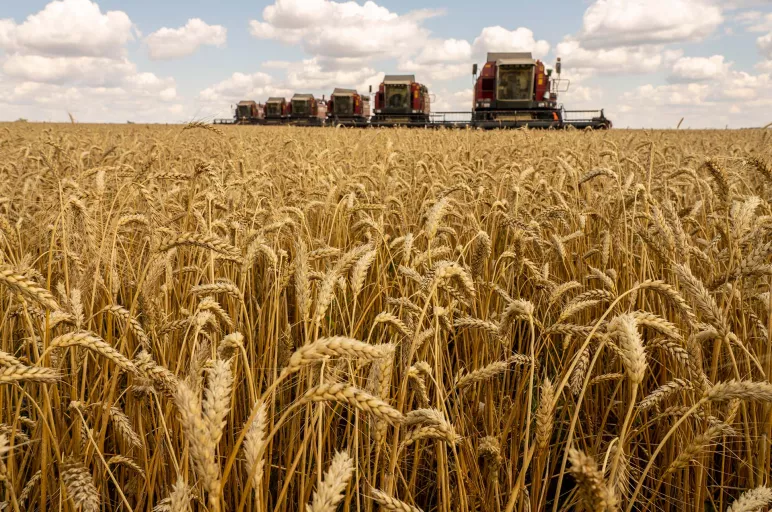
Tackling the Global Wheat Supply Shortage Amid the Ukraine War
- Wheat prices have been steadily rising after the Russia-Ukraine war disrupted exports of the crop
- Wheat supply is not expected to improve much in 2022 leading to acute shortage in many importing countries
- Australia and India can be considered as alternatives for countries reliant on wheat imports
May 02, 2022 | Agro
Wheat prices reached a 14-year high in March amid the Russia’s invasion of Ukraine. The warfare in Europe's breadbasket has heightened the risk of serious food shortages and hunger in several parts of the world.
For instance, wheat futures on the Chicago Board of Trade have been steadily rising since the war began on February 20, peaking to $ 1294/Bu in the first week of March, and now settling at $1095/Bu as on April 26.
Wheat supply chain disruptions
The war has exaggerated an already bad wheat supply situation.According to the International Monetary Fund, wheat prices rose by 80% between April 2020 and December 2021 since the crops were already trading at a high value globally due to pandemic-related shipping disruptions, rising farming costs and adverse weather conditions.
Russia and Ukraine together account for one third of global wheat exports.
Due to Russia's invasion of Ukraine, which compromised Ukraine's ability to produce wheat, wheat prices have skyrocketed. There was also an increase in wheat demand as several countries suspended or terminated wheat trade connections with Russia.
Moreover, the conflict has blocked shipping to the Sea of Azov located off Ukraine's southern coast, with dozens of ships queuing at the Black Sea inlet.
To manage domestic wheat needs, the Ukrainian government banned the export of wheat and other food necessities in March, all of which has caused a drastic shift in global wheat supply chain.
The impact of wheat shortage
Due to the global nature of agricultural commodity markets, a contraction in wheat supply from Ukraine and Russia has resulted in tightening markets, making prices more volatile. For instance, the scarcity is particularly severe in countries that rely substantially on imports – nearly 25 countries acquire half of their supplies from Russia and Ukraine.
Egypt, Turkey, Bangladesh, Pakistan, and Indonesia, to name a few, are heavily reliant on Russian and Ukrainian wheat. In Egypt and Pakistan, 80% of wheat imports come from Russia and Ukraine, while 70 % of wheat imports to Turkey and 50% to Bangladesh originate from Russia and Ukraine.
The United Nations has also warned that Russia's invasion of Ukraine might cause global famine, especially in Yemen, Ethiopia, and Russia.
According to IMF, global average food inflation hit 7.8% in January 2022, the highest in seven years. Global food prices touched an all-time high in February, climbing roughly 2.1 %. Moreover, the disruption of grain supplies is increasing the risk of additional global food inflation in the coming months.
Prolonged conflict in the region is estimated to jeopardize the wheat supply of not just 2022, but for several years in the future.
Moreover, Russia being a significant supplier of commodities such as fuel, fertilizer and insecticides means further complications for farmers. Therefore, the wheat supply is expected to stay limited throughout 2022 keeping the prices high.
The way ahead
Even if we consider the best-case scenario of the Ukraine-Russia war coming to an end soon, there is no scope for the wheat supply to increase in 2022. The war has led to an acute wheat shortage in many dependent countries.
The only a ray of hope arises from alternative wheat producers which could help stem the global wheat shortage. Top producers such as India, Australia and the U.S. will boost wheat export to fill the void created by the war.
India, the second largest producer of wheat, has the potential to ship 12 million tons in 2022-23 compared to 8.5 million tons in 2021-22.
Top 10 Wheat Producing Countries in 2022 (Million Tons)
| China | 134 |
| India | 107 |
| Russia | 85 |
| United States | 49 |
| Canada | 35 |
| France | 30 |
| Pakistan | 25 |
| Ukraine | 24 |
| Germany | 22 |
| Turkey | 20 |
The Australian Bureau of Agricultural and Resource Economics and Sciences has forecast a record wheat crop of 36.3 million tons for 2021-22 ending June, which is 5% higher than 2020-21.
Moreover, improved circumstances for the Kansas winter wheat harvesting in the near future has also boosted the likelihood of additional supplies.
Learn how GEP can help you mitigate the impact of the Russia-Ukraine war on your supply chain.



